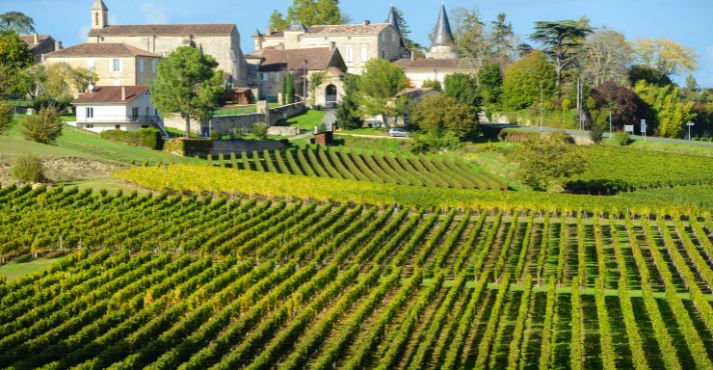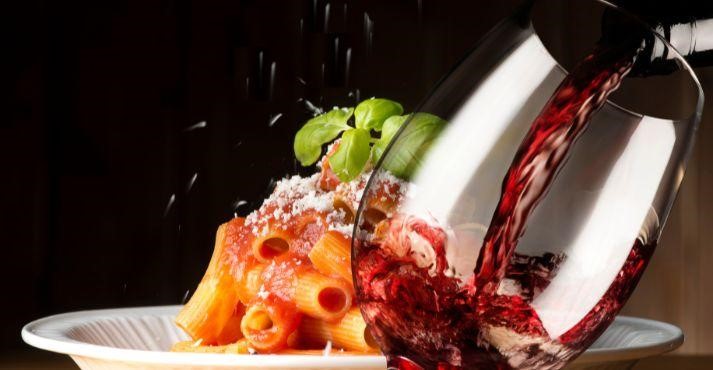Cabernet Sauvignon, often referred to as the “King of Red Wines,” is one of the world’s most popular and widely recognized grape varieties.
Known for its deep, rich flavors and remarkable aging potential, this red wine grape has captured the hearts of wine enthusiasts globally.
Did you know that Cabernet Sauvignon is the most planted wine grape in the world, covering over 340,000 hectares (about 840,000 acres) globally? Its resilience and ability to thrive in various climates have made it a favorite among winemakers and wine drinkers.
In this article, we will explore Cabernet Sauvignon’s history and origins, primary flavors and taste profile, handling and serving tips, food pairing suggestions, regional differences, and its unique “green” flavors.
Understanding Cabernet Sauvignon wine can improve your appreciation of its unique qualities and global significance.
What is Cabernet Sauvignon?

Cabernet Sauvignon is a red wine grape variety renowned for its bold flavors, high tannins, and excellent aging potential.
This grape produces some of the world’s most famous Cabernet Sauvignon wines. It is characterized by rich notes of black cherry, black currant, and a hint of graphite. Its thick skin and resistance to weather conditions make it a resilient winemaker choice.
The taste of Cabernet Sauvignon often includes layers of complexity that evolve with age, making it a favorite among wine collectors and enthusiasts. Besides its fruity notes, Cabernet Sauvignon is also known for its minerality, which adds a distinct, almost earthy quality to its flavor profile.
Known for its versatility, Cabernet Sauvignon wine can be enjoyed young or aged for several years to develop deeper flavors
Historical Roots
Cabernet Sauvignon traces its origins to Bordeaux, France, and was discovered in the seventeenth century. This natural wine is a combination of Cabernet Franc and Sauvignon Blanc,
This genetic parentage gave the grape its unique characteristics, combining the robustness of Cabernet Franc with the crispness of Sauvignon Blanc.
Bordeaux winemakers included it for its resilience and aging potential, establishing Cabernet Sauvignon as a cornerstone of the region’s renowned wines.
Characteristics of Cabernet Sauvignon

Many people love Cabernet Sauvignon’s rich flavors and complexity, which makes it a favorite red wine. Let’s explore what makes this grape so unique.
1. Distinct Flavor Profile
Cabernet Sauvignon is known for its bold and distinct flavors. Here are some of the signature tastes you might find in this wine:
- Blackcurrant is the most common flavor, giving the wine a rich, fruity taste.
- Plum: Adds a sweet and juicy note.
- Herbal Notes: You might taste hints of mint or eucalyptus, which give the wine a fresh quality.
- Oak Aging Influences: When aged in oak barrels, Cabernet Sauvignon can pick up flavors like vanilla, cedar, and spice.
These flavors make Cabernet Sauvignon wine versatile and enjoyable for many wine lovers. The influence of oak aging is particularly significant, adding layers of complexity to the wine’s profile. This makes it stand out in the wine market for its rich taste and aging potential.
2. Aromatics
The aroma of a wine is a big part of its overall experience. Here are some of the aromatic qualities of Cabernet Sauvignon wine:
- Black Cherry: This sweet and fruity smell is often the first thing you notice.
- Green Bell Pepper: This gives a unique, slightly spicy scent that some people love.
- Spices: Depending on how the wine is made, you might smell things like black pepper, cinnamon, or cloves.
These aromas add to the complexity and enjoyment of drinking Cabernet Sauvignon. The distinct smell of green bell pepper and spices can make Cabernet Sauvignon easily recognizable even before taking the first sip.
3. Tannin Structure and Body
Cabernet Sauvignon is famous for its high tannin content. Tannins are compounds that give the wine a dry, sometimes puckering feeling in your mouth. Here’s why tannins are essential:
- High Tannins help the wine age well. Over time, tannins soften, and the wine develops new flavors.
- Whole Body: This means the wine feels heavy and rich in your mouth, which many people find satisfying.
- Aging Potential: Cabernet Sauvignon can be aged for many years because of its high tannin content and entire As it ages, it can develop even more complex flavors.
Cabernet Sauvignon’s strong tannin structure and entire body make it a favorite among red wine enthusiasts who appreciate a wine that can stand the test of time. Its taste is both powerful and elegant, making it a prime choice for those who enjoy strong wines.
Major Wine Regions for Cabernet Sauvignon

Vineyard in France
Bordeaux, France
Bordeaux is the birthplace of Cabernet Sauvignon, and it remains one of the most prestigious regions for this grape. The Left Bank of Bordeaux, particularly areas like Médoc, is renowned for producing some of the finest Cabernet Sauvignon wines in the world.
The typical styles from this region are characterized by blackcurrant and plum flavors combined with a complex blend of herbal and earthy notes.
Wines from Médoc often have a robust tannin structure and excellent aging potential. Bordeaux’s gravelly soils provide excellent drainage, which is ideal for growing and making the best Cabernet Sauvignon.
Napa Valley, California
Napa Valley is a key player in the Cabernet Sauvignon red wine world. It gained international fame after the 1976 Judgment of Paris, in which a Napa Valley Cabernet beat top French wines in a blind tasting.
The unique climatic conditions of Napa Valley, with its warm days and cool nights, create perfect conditions for Cabernet Sauvignon. This region is known for producing rich, full-bodied wines with blackberry, black cherry, and mint flavors.
Some key wineries in Napa Valley include Stags’ Leap, Robert Mondavi, and Silver Oak. These wineries have helped to cement Napa Valley’s reputation as a premier region for Cabernet Sauvignon wines and grapes.
Other Notable Regions
- Australia’s Coonawarra is famous for its unique terra rossa soil, which produces Cabernet Sauvignon with distinct blackcurrant and eucalyptus The cool climate and fertile soil contribute to the wine’s intense color and firm tannins.
- Chile’s Maipo Valley is another notable region for Cabernet Sauvignon. The cooling Pacific Ocean breezes, and the hot inland Andes Mountains create a Mediterranean climate ideal for this grape. Chilean Cabernet Sauvignon is known for its blackberry, black cherry, and green peppercorn flavors, with a balance of fruitiness and structure.
- South Africa’s Stellenbosch is recognized for producing Cabernet Sauvignon with a unique character—the region’s diverse terroir and climate produce wines with dark fruit flavors, tobacco, and spice. The wines from Stellenbosch often have a good balance of acidity and tannins, making them suitable for aging.
These regions each offer something unique to Cabernet Sauvignon, showcasing the grape’s versatility and adaptability to different climates and soils.
Food Pairings of Cabernet Sauvignon

Classic Pairings
Cabernet Sauvignon food pairing balances the wine’s bold flavors with equally robust dishes. Traditional pairings include:
- Grilled Meats: The rich, smoky flavors of grilled steaks, lamb chops, and burgers complement the deep fruit notes and tannins of Cabernet Sauvignon.
- Hearty Stews: Beef stew, pot roast, and other slow-cooked dishes have rich, savory flavors that match the wine’s intensity.
- Strong Cheeses: Cheeses like aged cheddar, gouda, and blue cheese work well with Cabernet Sauvignon due to their intense flavors and creamy textures, which balance the wine’s tannins and acidity.
These classic wine pairings work well because the rich and fatty foods soften the wine’s tannins, while the wine’s acidity cuts through the food’s richness, creating a balanced and enjoyable dining experience.
Innovative Pairings
Modern food pairings for Cabernet Sauvignon wine highlight the wine’s versatility and adaptability to different flavors and cuisines. Some innovative ideas include:
- Plant-Based Options: Hearty plant-based dishes like mushroom risotto, lentil stew, and grilled portobello mushrooms pair beautifully with Cabernet Sauvignon. The wine’s depth enhances the umami flavors in these dishes.
- Spicy Dishes: While not traditionally paired with spicy food, Cabernet Sauvignon can complement mildly spicy dishes like BBQ ribs with a tangy sauce or spicy sausage pasta. The wine’s fruitiness and tannins balance the spice.
- International Cuisines: Cabernet Sauvignon pairs well with diverse international dishes such as Indian lamb curry, Mexican mole, and Korean BBQ. These dishes have bold flavors that match the intensity of the wine.
Exploring innovative pairings can bring out different aspects of wine and provide a new appreciation for its complexity. Cabernet Sauvignon wines offer a versatile pairing experience that can boost any meal, whether sticking to classic pairings or trying something new.
Leading Producers and Iconic Labels
Top Bordeaux Châteaux
Bordeaux is home to some of the most prestigious producers of Cabernet Sauvignon and the most famous Cabernet Sauvignon Wines. Among the top châteaux are:
- Château Margaux: Renowned for its elegant and powerful wines, Château Margaux produces some of the finest Cabernet Sauvignon blends in Bordeaux. The wines are known for their complex flavors of blackcurrant, plum, and a hint of graphite.
- Château Latour: Known for its longevity and depth, Château Latour’s wines are a benchmark for quality. The Cabernet Sauvignon wine from Latour is characterized by its rich fruit flavors and robust tannin structure.
- Château Mouton Rothschild: Famous for its luxurious and opulent wines, Château Mouton Rothschild blends Cabernet Sauvignon with other Bordeaux varieties to create powerful and refined wines.
Premier Napa Valley Wineries
Napa Valley is celebrated for its exceptional Cabernet Sauvignon wines. Critical producers in this region include:
- Robert Mondavi: A pioneering winery in Napa Valley, Robert Mondavi’s Cabernet Sauvignon wines are known for their rich, full-bodied character and flavors of blackberry, black cherry, and mint.
- Opus One: A collaboration between Robert Mondavi and Baron Philippe de Rothschild, Opus One produces iconic Cabernet Sauvignon wines that blend Old World finesse with New World fruitiness. The wines are noted for their balance, complexity, and aging potential.
International Standouts
Beyond Bordeaux and Napa Valley, several international producers are renowned for their Cabernet Sauvignon:
- Penfolds (Australia): Penfolds is famous for its Bin 707, a robust and full-bodied Cabernet Sauvignon showcasing the best Australian winemaking. The wine is known for its intense fruit flavors, firm tannins, and ability to age gracefully.
- Concha y Toro (Chile): One of the largest wine producers in Latin America, Concha y Toro’s Don Melchor is a standout Cabernet Sauvignon. The wine features flavors of blackberry, black cherry, and green peppercorn, reflecting the unique terroir of Chile’s Maipo Valley.
Selecting and Serving Cabernet Sauvignon

Buying Tips
When selecting a quality bottle of Cabernet Sauvignon wine, consider a few key factors:
- Vintage: The year the wine was produced can significantly impact its flavor. Look for vintages from well-regarded years for the region. For example, 2015 and 2016 were excellent years for Bordeaux, while 2012 and 2014 were remarkable for Napa Valley.
- Label Information: Check the label for details about the winery, the region, and any awards the wine may have won. Wines from reputable producers and well-known regions like Bordeaux, Napa Valley, and Chile’s Maipo Valley are usually a safe bet.
- Price: A higher price indicates better quality, but you can still find great Cabernet Sauvignon wines at reasonable prices. Feel free to try recommendations from wine shop staff or look up reviews online.
Optimal Serving
To fully enjoy Cabernet Sauvignon wine, follow these serving recommendations:
- Serving Temperature: To bring out its best flavors, serve Cabernet Sauvignon at a temperature between 60-68°F (15 and 20°C).
- Decanting: Decant the wine for about an hour before serving. This allows the wine to breathe and enhances its aromas and flavors.
- Glassware: An oversized wine glass with a large bowl helps concentrate the aromas and allows the wine to breathe, enhancing the tasting experience.
These practices will help you get the most out of your Cabernet Sauvignon wine and enjoy its full flavors and aromas.
Conclusion
Cabernet Sauvignon is the king of red wines, celebrated for its bold flavors, rich aromatics, and impressive aging potential.
As this guide explains, it is a grape variety known for producing full-bodied red wines with high tannins and a complex profile of dark fruit flavors, often accompanied by hints of green bell pepper, tobacco, and oak.
From its origins in Bordeaux to its prominence in Napa Valley and beyond, Cabernet Sauvignon continues to captivate wine enthusiasts worldwide.
Whether you’re enjoying a classic pairing with grilled meats or exploring innovative combinations with plant-based dishes, this versatile wine offers a delightful experience for every palate.
Understanding how to select, serve, and appreciate Cabernet Sauvignon can improve your wine experience and bring you closer to the heart of the world’s most beloved grape.





























